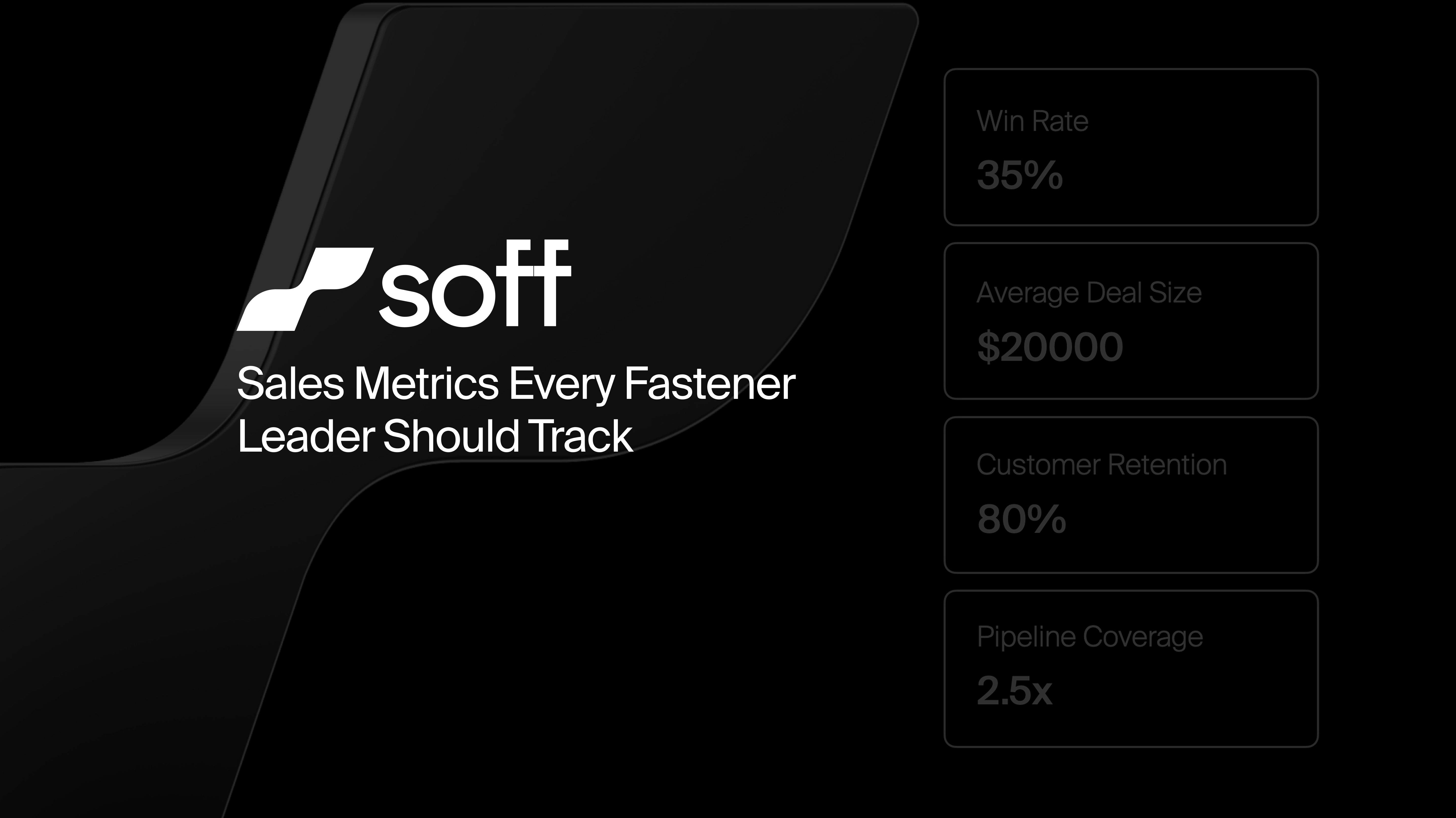Sales Metrics Every Fastener Sales Leader Should Track
6 Metrics to Keep on Your Radar as a Fastener Leader

When we started building a sales solution for the fastener industry, we dove deep into one big question:
Which sales metrics actually help companies grow, and which ones just look good on a dashboard?
After months of research and conversations with sales leaders in industrial and manufacturing firms, one thing became clear:
The strongest teams monitor a balanced mix of lagging and leading metrics.
Not the obvious ones like margin or total revenue, but tangible, actionable metrics that tell you what is working and where you need to act next.
Below are some of the most useful metrics we have found. Think of them as a strong baseline, not a full list, to give sales leaders visibility into performance and early signals of risk or opportunity.
Lagging Metrics: The Scoreboard After the Game
These metrics tell you how you have performed in the past. They help you evaluate outcomes, detect trends, and course-correct for future quarters.
1. Win Rate
Formula: Won Deals ÷ Total Proposals or Opportunities
Segment By: Customer, Industry, Deal Size, Region, Sales Rep, Product Type
Why It Matters:
It gives you a direct measure of your competitiveness and sales effectiveness.
If It’s Low:
Call five recently lost customers, ask why, then look at what your top performers are doing differently and try to replicate it.
2. Average Deal Size
Formula: Sum of Contract Values ÷ Number of Contracts
Why It Matters:
It shows whether your team is skewing toward higher or lower value deals over time.
Example:
If you close 20 orders totaling $200K → average deal size = $10K.
If It’s Low:
Consider volume discounts, bundling upsells, or multi-site packaging to raise deal value.
3. Sales Cycle Length
Formula: Average time between proposal and close
Segment By: Industry, Customer Type
Why It Matters:
A longer sales cycle can signal inefficiencies in quoting, qualification, or follow-up timing.
It also helps you set realistic expectations for pipeline filling and forecasting. If your average cycle is 60 days, you need to be feeding in new deals well before the quarter’s end.
Action Tip:
Track cycle length by rep or customer segment. Shorten the cycle by accelerating quotes, improving qualification, or optimizing follow-up cadence.
4. Customer Retention / Repeat Purchase Rate
Formula: (# Repeat Customers ÷ Total Customers over Period)
Example:
Start with 200 active buyers, gain 30 new, end with 210 → (210 – 30) ÷ 200 = 90% retention
Why It Matters:
It is far more cost-effective to keep customers than to win new ones. Research shows that acquiring a new customer can cost five to seven times more than retaining an existing one (Forbes).
Additionally, Bain & Company found that improving customer retention by just 5% can increase profits by 25% to 95% (Bain & Company).
Action Tip:
Watch for “silent attrition,” when customers keep buying but at decreasing volumes. Reach out proactively to reengage or upsell.
Leading Metrics: Early Warning Signs
These metrics help you predict what is ahead. They focus on the inputs, the things your team does before results show up.
1. Pipeline Coverage Ratio
Formula: Total Pipeline Value ÷ Sales Target
Example:
Quarterly target = $1M, open opportunities = $2.5M → Pipeline Coverage = 2.5×
Why It Matters:
It tells you whether your team has enough opportunity to reliably hit goals. According to Gartner, reps with at least 2.5× pipeline coverage have a significantly higher chance of hitting quota.
In more competitive industrial segments, planning for 4× coverage can offer better predictability.
Action Tip:
If your coverage is low, ramp up lead generation, accelerate discovery meetings, or shift resources toward high-potential territories.
2. Activity Metrics (Calls, Visits, Quotations, Follow-Ups)
Track: Per rep, weekly or monthly
Why It Matters:
These actions feed your pipeline. If reps reduce activity, future deals will shrink.
Action Tip:
Set minimum activity baselines. If pipeline growth slows, increase outreach, revisit dormant accounts, and re-evaluate sales cadence.
The Bottom Line
These are some of the key metrics that help fastener and industrial sales teams make better, data-backed decisions. A good balance of leading and lagging metrics shows what’s working, what’s not, and where to focus next. When tracked consistently, they turn your sales dashboard into a real-time guide for growth.
Sources
- Bain & Company: Loyalty Rules (Frederick Reichheld)
- Forbes Business Council: Customer Retention vs Acquisition
- Gartner: Improving Sales Forecasting with Pipeline Analytics
Ready To Stop Losing Deals?
Increase Your Revenue with Soff.
%201.webp)
